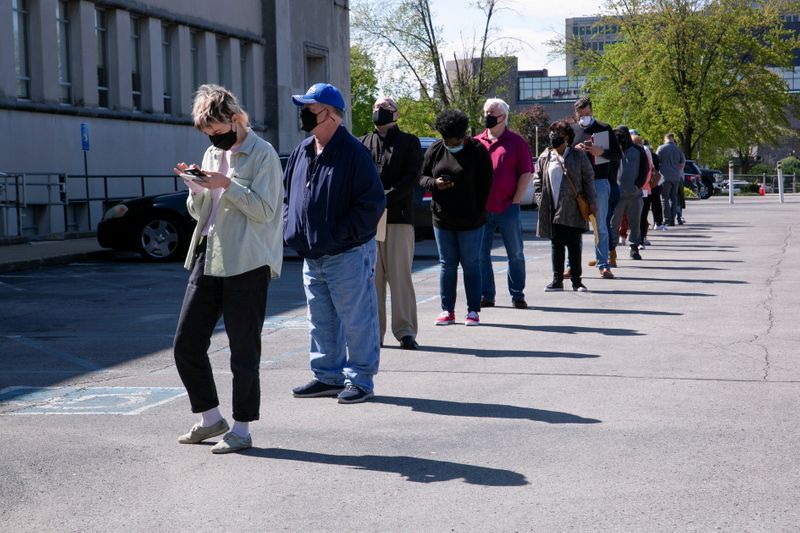By Lucia Mutikani
WASHINGTON (Reuters) - The number of Americans filing new claims for unemployment benefits dropped further below 500,000 last week, but jobless rolls swelled in early May, which could temper expectations for an acceleration in employment growth this month.
Indeed, other data on Thursday showed a measure of factory employment in the mid-Atlantic region fell in May. But businesses in the region that covers eastern Pennsylvania, southern New Jersey and Delaware increased employees' work hours, suggesting problems finding workers. Labor and raw material shortages were likely behind the significant slowdown in the pace of growth in output at the region's factories this month.
The supply constraints follow pent-up demand unleashed by the economy's reopening after being severely disrupted by the COVID-19 pandemic for more than a year.
"If the data are taken at face value, it would suggest both a reduction in layoffs and a slowing in hiring, which given the rising level of labor demand could only be explained by a reduction in labor supply," said Conrad DeQuadros, senior economic advisor a Brean Capital in New York.
Initial claims for state unemployment benefits fell 34,000 to a seasonally adjusted 444,000 for the week ended May 15, the Labor Department said. That was the lowest since mid-March 2020 and held claims below 500,000 for two straight weeks.
Economists polled by Reuters had forecast 450,000 applications for the latest week. Claims remain well above the 200,000 to 250,000 range that is viewed as consistent with healthy labor market conditions. They have dropped from a record 6.149 million in early April 2020.
Applications are likely to decrease further in the weeks ahead after Republican governors in at least 21 states announced they would withdraw next month from unemployment programs funded by the federal government. These included a weekly $300 subsidy, which businesses say are encouraging the jobless to stay at home instead of seeking work.
From manufacturing to restaurants and bars, employers are scrambling to find workers, even as nearly 10 million Americans are officially unemployed. The enhanced unemployment benefits give more than most jobs paying minimum wages, which range from as low as $7.25 per hour to as high as $15.
Stocks on Wall Street rebounded after a three-day slide. The dollar slipped against a basket of currencies. U.S. Treasury prices rose.
SUPPLY CONSTRAINTS
Lack of child care facilities, with most schools offering partial in-person learning, as well as lingering fears of COVID-19 and pandemic-related retirements are also believed to be contributing to the worker shortage, which curbed hiring in April. The government-funded benefits expire in early September and school districts are expected to resume in-person classes in the fall, which economists hope will boost the labor pool.
Minutes of the Federal Reserve's April 27-28 policy meeting published on Wednesday acknowledged reports of businesses
"having trouble hiring workers." They noted some of the factors behind the worker scarcity "were seen as likely to remain significant while pandemic-related risks persisted."
But some economists, including at the White House, disagree that the generous benefits are a deterrent to work.
"Unemployment aid is not keeping workers on the sidelines," said Andrew Stettner, senior fellow at The Century Foundation. "Emergency unemployment aid is doing what it is meant to do, serving as a temporary lifeline while workers search for and return to work."
The claims data included the period during which the government surveyed business establishments for the nonfarm payrolls component of May's employment report. The economy created 266,000 jobs in April after adding 770,000 in March.
To get a better picture of how hiring fared in May, economists will await data next week on the number of people continuing to receive benefits after an initial week of aid. The so-called continuing claims are reported with a one-week lag.
Continuing claims increased 111,000 to 3.751 million during the week ended May 8. There were about 16 million people on unemployment benefits under all programs on May 1.
"The overall trend in labor market conditions remains positive, even though it is unclear how that will translate quantitatively into next month's employment data," said Lou Crandall, chief economist at Wrightson ICAP (LON:NXGN) in Jersey City.
With more than a third of the population vaccinated, restrictions on services industry businesses are being lifted. The economy is also being underpinned by nearly $6 trillion in pandemic relief provided by the government over the past year.
In a separate report on Thursday, the Philadelphia Fed said its business activity index fell to 31.5 this month from 50.2 in April. A reading above zero indicates growth in the mid-Atlantic region's manufacturing sector.
Its measure of new orders received by factories grew at a slower pace in May relative to April as did shipments. But backlogs of uncompleted work continued to pile up, testament to the inputs shortage. The survey's gauge of factory employment dropped to a reading of 19.3 from 30.8 in April. The average workweek index jumped six points to 35.5.

Despite the bottlenecks in the supply chain, the economy is powering ahead. A third report from the Conference Board showed its gauge of future economic activity surging above its pre-pandemic level in April.
"The economy is solidifying at a high level of growth," said Joel Naroff, chief economist at Naroff Economics in Holland, Pennsylvania.